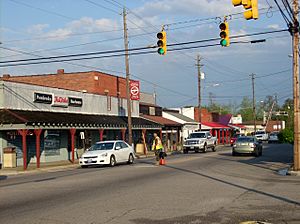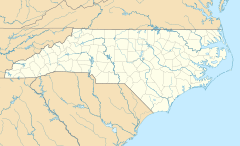Pembroke, North Carolina facts for kids
Quick facts for kids
Pembroke, North Carolina
|
||
|---|---|---|

East 3rd Street in Pembroke
|
||
|
||
| Nickname(s):
Home of the Lumbee Tribe
|
||
| Country | United States | |
| State | North Carolina | |
| County | Robeson | |
| Incorporated | 1895 | |
| Named for | Pembroke Jones | |
| Area | ||
| • Total | 3.18 sq mi (8.23 km2) | |
| • Land | 3.18 sq mi (8.23 km2) | |
| • Water | 0.00 sq mi (0.00 km2) | |
| Elevation | 171 ft (52 m) | |
| Population
(2020)
|
||
| • Total | 2,823 | |
| • Density | 888.02/sq mi (342.88/km2) | |
| Time zone | UTC-5 (Eastern (EST)) | |
| • Summer (DST) | UTC-4 (EDT) | |
| ZIP code |
28372
|
|
| Area codes | 910, 472 | |
| FIPS code | 37-51080 | |
| GNIS feature ID | 2407093 | |
Pembroke is a town in Robeson County, North Carolina, United States. It is located about 90 miles (145 km) northwest of the Atlantic Coast. In 2020, the town had a population of 2,823 people. Pembroke is special because it is the main home of the Lumbee Tribe of North Carolina. It is also where the University of North Carolina at Pembroke is located.
Contents
Geography and Location
Pembroke is a town that covers about 3.18 square miles (8.23 square kilometers) of land. There is no water area within the town limits. It is located entirely on land.
People Living in Pembroke
Pembroke has grown a lot over the years. Here's how its population has changed:
| Historical population | |||
|---|---|---|---|
| Census | Pop. | %± | |
| 1910 | 258 | — | |
| 1920 | 829 | 221.3% | |
| 1930 | 524 | −36.8% | |
| 1940 | 783 | 49.4% | |
| 1950 | 1,212 | 54.8% | |
| 1960 | 1,372 | 13.2% | |
| 1970 | 1,982 | 44.5% | |
| 1980 | 2,698 | 36.1% | |
| 1990 | 2,241 | −16.9% | |
| 2000 | 2,399 | 7.1% | |
| 2010 | 2,973 | 23.9% | |
| 2020 | 2,823 | −5.0% | |
| U.S. Decennial Census | |||
Who Lives in Pembroke?
In 2020, there were 2,823 people living in Pembroke. These people lived in 879 households, which are like family units or groups of people living together. About 529 of these households were families.
The people in Pembroke come from many different backgrounds:
- Most people, about 64.82%, are Native American.
- About 13.35% are White (not Hispanic).
- About 11.09% are Black or African American (not Hispanic).
- A smaller number of people are Asian (0.57%), Pacific Islander (0.04%), or from other backgrounds (6.27%).
- About 3.86% of the people are Hispanic or Latino.
History of Pembroke
Pembroke started as a small area around a place called Campbell's Mill in 1860. A railroad line was built through the area, but a town didn't really grow there at first.
How the Town Began
In 1892, a different railroad company decided to build a new line. They planned to go through a nearby community, but a local person asked them to move the line a few miles west to Campbell's Mill. This is where Pembroke began to grow. A train station was built, and a company called the Atlantic Land and Improvement Company planned out streets. They sold land, and the area quickly became a busy place for business.
By 1895, about 150 people lived there. That same year, it officially became the town of Pembroke. It was named after a railway worker named Pembroke Jones.
Growth and Changes
In 1909, a school called the Croatan Normal School moved to Pembroke. This school later became the University of North Carolina at Pembroke. At first, most buildings were made of wood. The first brick building was built in 1922. A large general store, Pates Supply Company, became the biggest business in town.
A main road was built in 1923, and the first street was paved in 1932. Pembroke became an important center for the Lumbee people's businesses. Because many Lumbee people lived there, the town was different from other places in the South during the early 1900s. It did not follow some strict rules that were common elsewhere.
Town Leadership
When Pembroke first became a town, its citizens voted for a mayor and a board of commissioners every year. However, for a while, a small group of white leaders controlled the town's government. By 1917, the Lumbee community had grown a lot and wanted more say.
The state government in Raleigh changed the rules. The Governor of North Carolina then chose the mayor and commissioners. Usually, there were two Lumbee commissioners and two white commissioners, with a white mayor. In 1945, a group of Lumbee people asked the governor to change this system. Two years later, the town went back to having elected leaders. Pembroke then chose its first Lumbee mayor.
Important Buildings
Two important buildings in Pembroke are listed on the National Register of Historic Places. These are the Old Main building at the University of North Carolina at Pembroke and the former Pembroke High School.
The Lumbee Tribe
Pembroke is the main center for the Lumbee Tribe of North Carolina. This is the largest state-recognized Native American tribe east of the Mississippi River. They do not have a reservation. The Lumbee people have a rich history, with some of their ancestors moving from nearby counties and states. In the 1950s, the people who identified as Native American in this area chose the name Lumbee. This name comes from what is now called the Lumber River.
University of North Carolina at Pembroke
Pembroke is home to the University of North Carolina at Pembroke (UNCP). This university offers master's degrees and is one of the 17 schools in the University of North Carolina system. It joined the UNC system in 1972 and officially became the University of North Carolina at Pembroke in 1996.
In the fall of 2022, 7,667 students were enrolled at UNCP. The university has a student-to-teacher ratio of 18:1, meaning there are 18 students for every teacher. The average class size is 20 students. U.S. News & World Report has said that UNCP has the safest campus among the UNC schools. It is also known for being one of the most diverse universities in the country. Its motto is: "Where learning gets personal."
Education in Pembroke
All the schools in Pembroke are part of the Robeson County Schools district.
Famous People from Pembroke
Many talented people have come from Pembroke, North Carolina:
- Nate Andrews – A former professional baseball pitcher. He was an All-Star in 1944.
- Chris Chavis – A professional wrestler known as "Tatanka" in the WWE.
- Harold Collins – Once known as the World's Strongest Native American.
- Charly Lowry – A singer and songwriter.
- Lee McRae – A national champion sprinter and a world champion in the 4x100 meter relay.
- Mike McRae – A long jumper who competed for the United States in the 1984 Summer Olympics.
- Ruth Revels – An American Indian activist and educator.
- Kelvin Sampson – A college basketball head coach.
See also
 In Spanish: Pembroke (Carolina del Norte) para niños
In Spanish: Pembroke (Carolina del Norte) para niños




